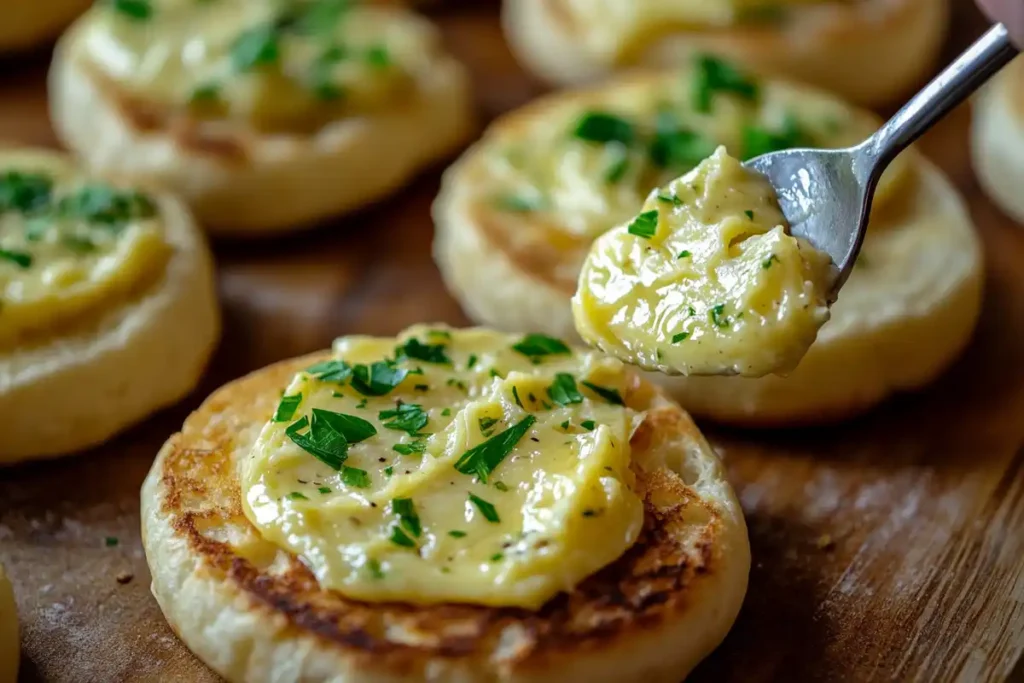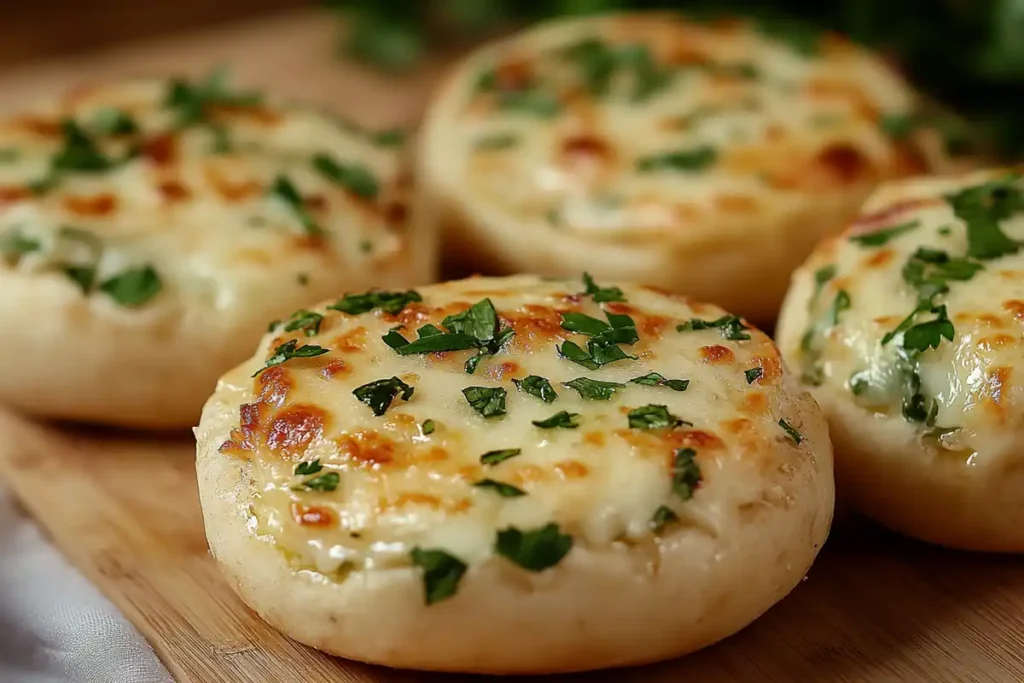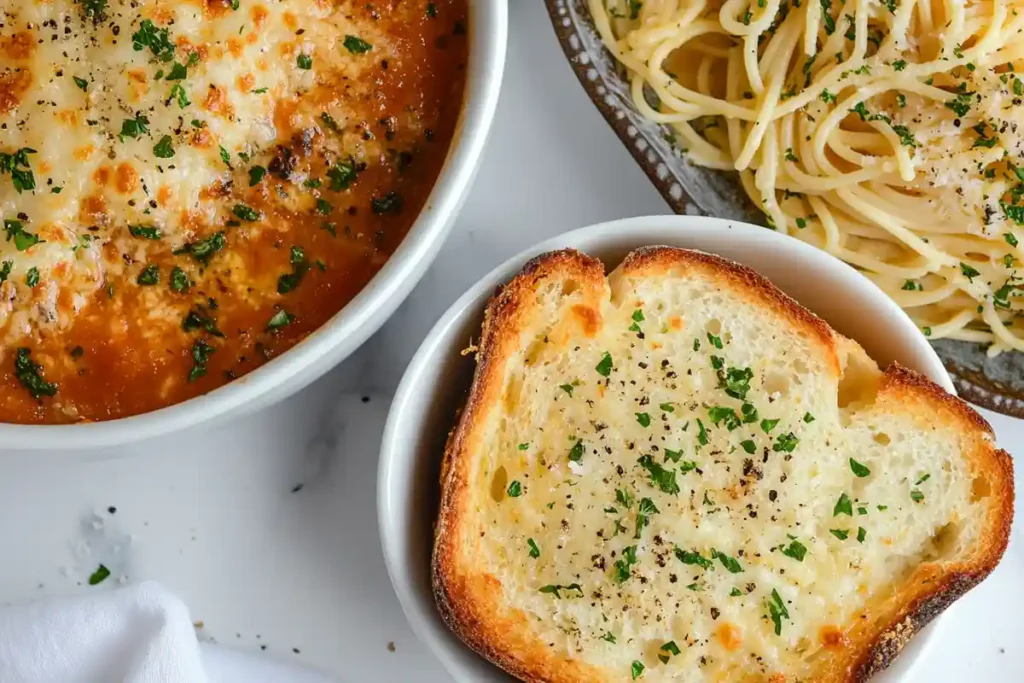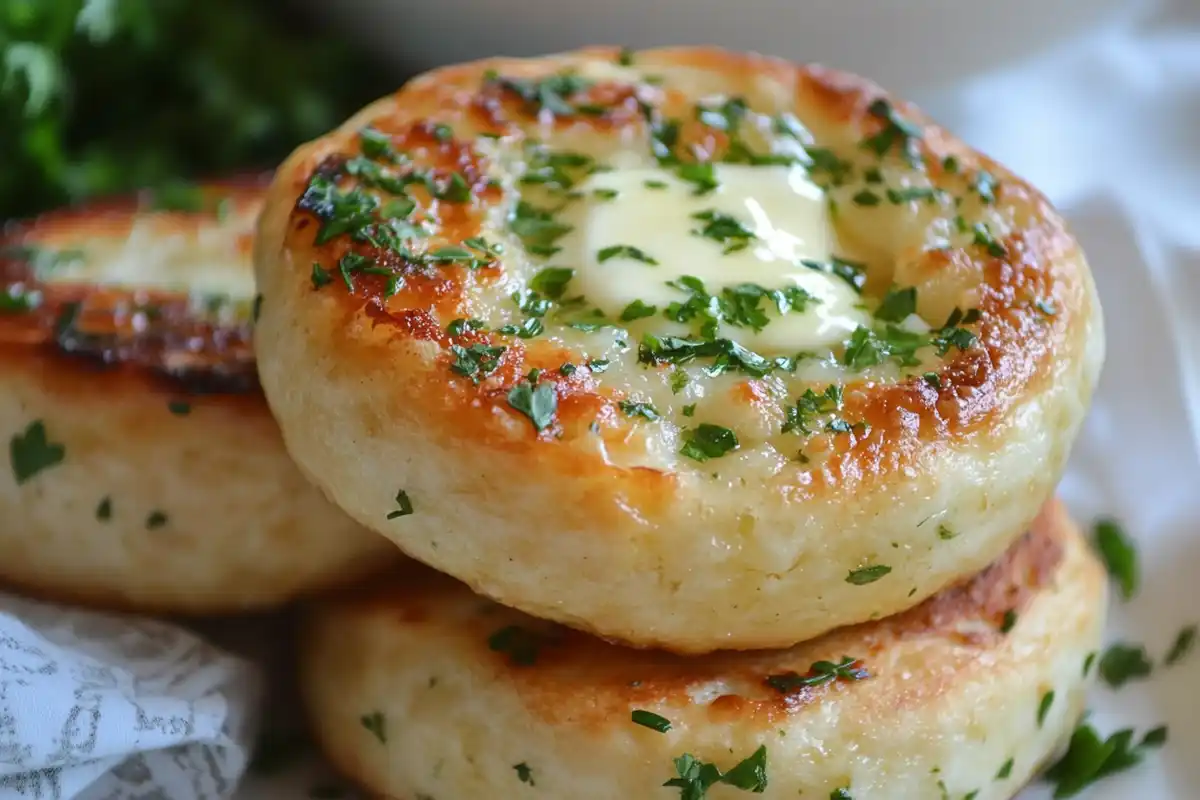Discover how to make English Muffin Garlic Bread—a crispy, flavorful, and easy-to-make alternative to traditional garlic bread for any occasion!
Understanding English Muffin Garlic Bread
What Is English Muffin Garlic Bread?
If you’re a fan of garlic bread but also love the nooks and crannies of an English muffin, this recipe is about to become your new favorite. English Muffin Garlic Bread is, as the name suggests, a combination of the crispy, buttery, and garlicky goodness of garlic bread with the unique texture and structure of English muffins. It’s not just about slapping some garlic butter on a muffin, though—this is a next-level upgrade to your bread game. The result? A snack or side dish that’s crispy on the outside, soft on the inside, and loaded with flavor.
A Unique Twist on Traditional Garlic Bread
Traditional garlic bread often uses baguettes or Italian bread, known for their crunchy crusts and fluffy interiors. But English muffins bring their own magic to the table. Their porous texture absorbs all that delicious garlic butter without becoming soggy, creating a flavor-packed bite every time. Plus, those golden crumbs on the bottom of English muffins? They add an extra layer of crunch that traditional garlic bread simply doesn’t offer.
Why English Muffin Garlic Bread Is Gaining Popularity
Versatility and Convenience of English Muffins
English muffins are already a staple in many households because they’re so versatile. You can eat them toasted with butter, make mini pizzas, or, yes, turn them into garlic bread. Unlike traditional loaves, they’re portioned into individual rounds, which means no slicing or worrying about uneven pieces. This convenience makes them perfect for quick snacks, dinner sides, or even creative appetizers. On top of that, their structure holds up beautifully under broilers or toasters, which is crucial when you’re trying to get that perfect garlic-butter glaze.
Health and Nutritional Factors Compared to Regular Bread
Here’s the thing: while garlic bread isn’t exactly diet food, using English muffins instead of regular bread can make it a bit lighter. Many English muffin brands are lower in calories and carbs compared to standard baguettes or artisan breads. Plus, they often come in whole-grain or multigrain options, which provide extra fiber. So, you can enjoy your garlic bread without as much guilt. That’s a win, right?
English muffins are a staple ingredient with endless possibilities, from breakfast sandwiches to unique recipes like English Muffin Garlic Bread. Check out this guide to discover how versatile English muffins can be for breakfast: Italian Breakfast: A Delicious Dive Into Tradition.
Who Should Try English Muffin Garlic Bread?
Perfect for Quick Snacks and Family Meals
Let’s be real—sometimes you need a snack that’s fast but still feels like you put in a little effort. English Muffin Garlic Bread is ideal for those moments. Whether it’s a mid-afternoon pick-me-up or a last-minute addition to a family dinner, it’s ready in no time. Just a few minutes of prep and a quick broil later, and you’re good to go. It’s also perfect for kids since the muffin halves are the perfect size for small hands.
A Great Option for Garlic Bread Enthusiasts
If you’re obsessed with garlic bread (and honestly, who isn’t?), this recipe is a must-try. It brings a fun twist to a classic favorite without straying too far from what makes garlic bread so crave-worthy. Plus, it’s customizable—you can make it cheesy, spicy, or even add some herbs to match your mood. For garlic bread fans who think they’ve tried it all, this is a fresh and exciting option.
The Basics of English Muffins and Garlic Bread
What Sets English Muffins Apart from Regular Bread?
At first glance, English muffins might seem like just another type of bread, but they’re anything but ordinary. Their unique structure, texture, and even the way they’re cooked make them stand out.
Structure and Texture of English Muffins
One of the key features of English muffins is their signature “nooks and crannies.” These tiny pockets are formed during the cooking process and are perfect for soaking up butter, garlic, or any other spread you love. The texture is slightly chewy, yet the exterior crisps up beautifully when toasted. This combination of softness and crunch makes them ideal for garlic bread, as they absorb flavor without falling apart.
What Are the Crumbs on the Bottom of English Muffins?
Ever noticed that coarse, crumbly layer on the bottom of an English muffin? That’s typically cornmeal or semolina, which is sprinkled on the dough before it’s cooked. This not only prevents sticking but also adds a subtle crunch to every bite. When transformed into garlic bread, this bottom layer contributes an extra dimension of texture, making the experience even more satisfying.
How Garlic Bread Differs from Garlic Toast
Garlic bread and garlic toast might seem interchangeable, but they have distinct differences that set them apart. Understanding these nuances helps highlight why English muffins work so well in this recipe.
Traditional Ingredients of Garlic Bread
Classic garlic bread is usually made with a long, crusty loaf like a baguette or ciabatta. It’s sliced, slathered with a mixture of butter, minced garlic, and parsley, and often baked until golden. Sometimes, it’s topped with cheese for an extra indulgent twist. The focus is on bold, buttery flavors with a slightly chewy texture underneath the crisp crust.
Variations in Preparation and Cooking
Garlic toast, on the other hand, often uses pre-sliced bread and is typically toasted in a toaster or under a broiler. While it’s quicker to prepare, it lacks the depth of flavor and texture that traditional garlic bread offers. Enter English muffins—they combine the convenience of toast with the rich, garlicky goodness of traditional garlic bread, giving you the best of both worlds.
Combining English Muffins with Garlic Bread Flavors
Choosing the Right Ingredients for Flavor

The beauty of English Muffin Garlic Bread lies in its simplicity, but the ingredients you choose can make or break the dish. For the garlic butter, fresh minced garlic is key—it delivers a more robust flavor compared to pre-minced or powdered options. High-quality butter, preferably unsalted, allows you to control the saltiness of the final dish. And don’t skimp on fresh herbs like parsley or basil; they brighten up the flavors beautifully.
Balancing Garlic, Butter, and Herbs on English Muffins
One of the trickiest parts of making garlic bread is achieving the right balance of flavors. Too much garlic can overpower the dish, while too little leaves it bland. The trick with English muffins is to evenly spread the garlic butter across the surface, ensuring each bite has a perfect mix of garlic, butter, and herbs. A pinch of flaky sea salt on top can add a nice finishing touch.
Making It Healthier with Low-Fat Options
For those watching their calorie intake, there are plenty of ways to lighten up this dish without sacrificing flavor. Swap regular butter for a low-fat or plant-based alternative, and consider using whole-grain English muffins for added fiber. You can also reduce the amount of butter and add a drizzle of olive oil instead, which provides healthy fats and a subtle richness.
Popular Add-Ons and Toppings for Customization
One of the best things about this recipe is how easily you can customize it. For cheese lovers, a sprinkle of mozzarella or parmesan takes it to another level. Craving something spicy? Add a dash of red chili flakes or a drizzle of hot honey. You can even experiment with toppings like roasted tomatoes, caramelized onions, or a dollop of pesto for a unique twist.
For an extra cheesy twist, try pairing this recipe with ideas inspired by breakfast classics, like these delicious options: Breakfast Nook Ideas: Cozy Spaces for Every Home.
Benefits of Using English Muffins for Garlic Bread
Texture and Portion Control Advantages
When it comes to garlic bread, the texture is everything. English muffins deliver a delightful crunch without being too dense, and their individual portions mean you can easily control serving sizes. This is especially handy if you’re cooking for one or two people and don’t want leftovers. Plus, their pre-sliced design saves time and ensures consistent results.
Faster Cooking Time Compared to Regular Bread
Another advantage of using English muffins is their quick cooking time. Because they’re already cooked, you only need a few minutes under the broiler or in the toaster oven to achieve the perfect golden crust. This makes them ideal for busy weeknights or last-minute meals. In contrast, traditional garlic bread often requires longer baking times, which isn’t always practical when you’re in a rush.
How to Make English Muffin Garlic Bread at Home
Step-by-Step Recipe Guide
If you’re ready to try English Muffin Garlic Bread at home, you’re in for a treat. It’s quick, simple, and endlessly satisfying. Below is an easy-to-follow recipe to get you started.
Ingredients You’ll Need
To whip up this dish, gather the following ingredients:
- 4 English muffins, split into halves
- 1/4 cup unsalted butter, softened
- 3 cloves garlic, finely minced
- 1/4 cup fresh parsley, chopped
- 1/4 cup grated parmesan cheese (optional)
- A pinch of salt
- Red chili flakes or black pepper (optional for heat)
Easy Preparation Steps for Beginners
- Preheat your oven: Set your broiler on high or your oven to 400°F if broiling isn’t an option.
- Prepare the garlic butter: In a small bowl, mix the softened butter, minced garlic, parsley, and salt. For a cheesier flavor, stir in half of the parmesan cheese.
- Assemble the muffins: Spread a generous layer of the garlic butter mixture evenly over each English muffin half. If desired, sprinkle with chili flakes for a spicy kick.
- Toast or broil: Place the muffins on a baking sheet, buttered side up. Broil for 2-3 minutes or bake for about 8-10 minutes, until the edges are golden and crispy.
- Serve and enjoy: Remove from the oven, sprinkle with the remaining parmesan cheese, and serve immediately.
Tips for Toasting Perfectly Evenly
For consistent results, place the baking sheet on the middle rack of your oven. This ensures even toasting without burning. Also, keep an eye on the muffins while broiling—they can go from perfectly golden to overly crisp in seconds!
Creative Variations of English Muffin Garlic Bread
Cheesy Garlic English Muffins

For cheese lovers, this version is a dream. After spreading the garlic butter, top each muffin with shredded mozzarella or a mix of mozzarella and cheddar. Broil until the cheese is bubbly and slightly browned. The result? A gooey, melty upgrade that pairs perfectly with soups or pasta dishes.
Spicy Garlic Bread with Chili Flakes
If you’re a fan of heat, this spicy variation is for you. Add extra red chili flakes or even a drizzle of spicy sriracha on top before broiling. This version is a fantastic pairing for creamy dishes like fettuccine alfredo, as the heat cuts through the richness.
Sweet and Savory Combinations
For a unique twist, try blending sweet and savory flavors. After toasting, drizzle the garlic bread with a bit of honey or maple syrup. It might sound unconventional, but the combination of salty, garlicky butter with a hint of sweetness is surprisingly addictive.
Want to explore more creative toppings? Learn how to elevate your breakfast bread game with recipes like these delightful twists: Brioche French Toast Casserole.
Real-World Uses for English Muffin Garlic Bread
As a Side Dish for Soups and Pasta

English Muffin Garlic Bread makes an ideal side dish for hearty soups like tomato bisque or creamy chowders. Its crispy texture complements the soft, warm consistency of soups perfectly. Similarly, it’s a match made in heaven with pasta dishes like spaghetti marinara, lasagna, or even a light lemon linguine.
As a Quick Breakfast or Snack Option
Don’t reserve this dish for dinner alone—it works wonderfully for breakfast or as a quick midday snack. Pair it with scrambled eggs or avocado for a savory morning meal, or enjoy it solo when you’re craving a small but satisfying bite.
Future Trends in Garlic Bread Recipes
Healthier Alternatives for Garlic Bread Lovers
As more people focus on healthier eating, recipes like English Muffin Garlic Bread are evolving. Expect to see versions made with gluten-free muffins or dairy-free garlic butter. Adding superfoods like spinach or kale into the mix might also become popular, giving a nutritious twist to this comfort food.
Innovative English Muffin-Based Recipes
Beyond garlic bread, English muffins are finding their way into more creative recipes. Think English muffin sliders, muffin-based breakfast pizzas, or even dessert versions with cinnamon and sugar. These trends highlight just how versatile and fun English muffins can be in the kitchen.
FAQs
Are English muffins healthier than bread?
Nutritional Comparison of English Muffins and Regular Bread
When it comes to choosing between English muffins and regular bread, it really depends on your nutritional goals. English muffins are often lower in calories and carbs than a typical slice of white or artisan bread. For example, a standard English muffin contains around 120–150 calories, while a slice of bread might have 80–120 calories. However, the portion size of an English muffin can make it more filling due to its density and texture.
Factors That Contribute to Health Differences
Whole-grain English muffins also offer more fiber, which is great for digestion and keeping you full longer. Meanwhile, regular bread can vary widely in nutritional content depending on the type—whole wheat, sourdough, and multigrain options are often similar to English muffins in health benefits. In other words, both can fit into a balanced diet, but English muffins might be a slightly lighter choice for garlic bread.
What is the difference between garlic bread and garlic toast?
Key Characteristics of Garlic Bread vs. Garlic Toast
Garlic bread and garlic toast may seem similar, but they’re not identical. Garlic bread typically uses a whole loaf, often sliced partway through to create pull-apart pieces, with garlic butter spread inside. It’s rich, indulgent, and perfect for sharing. Garlic toast, on the other hand, involves individual slices of bread toasted with a layer of garlic butter on top.
Differences in Cooking Techniques and Ingredients
Garlic bread is usually baked in foil to keep it soft and moist, while garlic toast is often broiled or toasted for a crispier texture. Additionally, garlic bread may include herbs, cheese, or other toppings, while garlic toast is simpler and quicker to prepare.
What are the crumbs on the bottom of English muffins?
Purpose of the Cornmeal or Flour Coating
The crumbs on the bottom of an English muffin aren’t just there for aesthetics—they serve a practical purpose. Cornmeal or semolina flour is added to prevent the dough from sticking to the baking surface during cooking. This simple addition makes handling and toasting the muffins much easier.
How It Affects Texture and Cooking
Beyond functionality, these crumbs add a slight crunch that enhances the overall texture of the muffin. When making English Muffin Garlic Bread, this coating helps create a crispier base, adding to the bread’s overall appeal.
What makes English muffins different from other breads?
Preparation Process and Unique Features
Unlike most breads, which are baked in an oven, English muffins are typically cooked on a griddle. This method gives them their distinct flat shape and chewy texture. The dough is often enriched with milk, giving the muffins a slightly softer and richer taste.
The Role of Yeast in English Muffins
Yeast is a key player in creating the airy structure of English muffins. The fermentation process produces the bubbles that lead to the iconic nooks and crannies. These pockets are perfect for soaking up butter, garlic, or any toppings you choose, making English muffins a standout choice for garlic bread.
Can English muffins be used for other recipes?
Absolutely! English muffins are one of the most versatile bread options out there. Beyond garlic bread, you can use them to make mini pizzas, breakfast sandwiches, or even desserts like bread pudding. Their sturdy texture holds up well to toppings, making them perfect for experimenting with new flavors and recipes.

